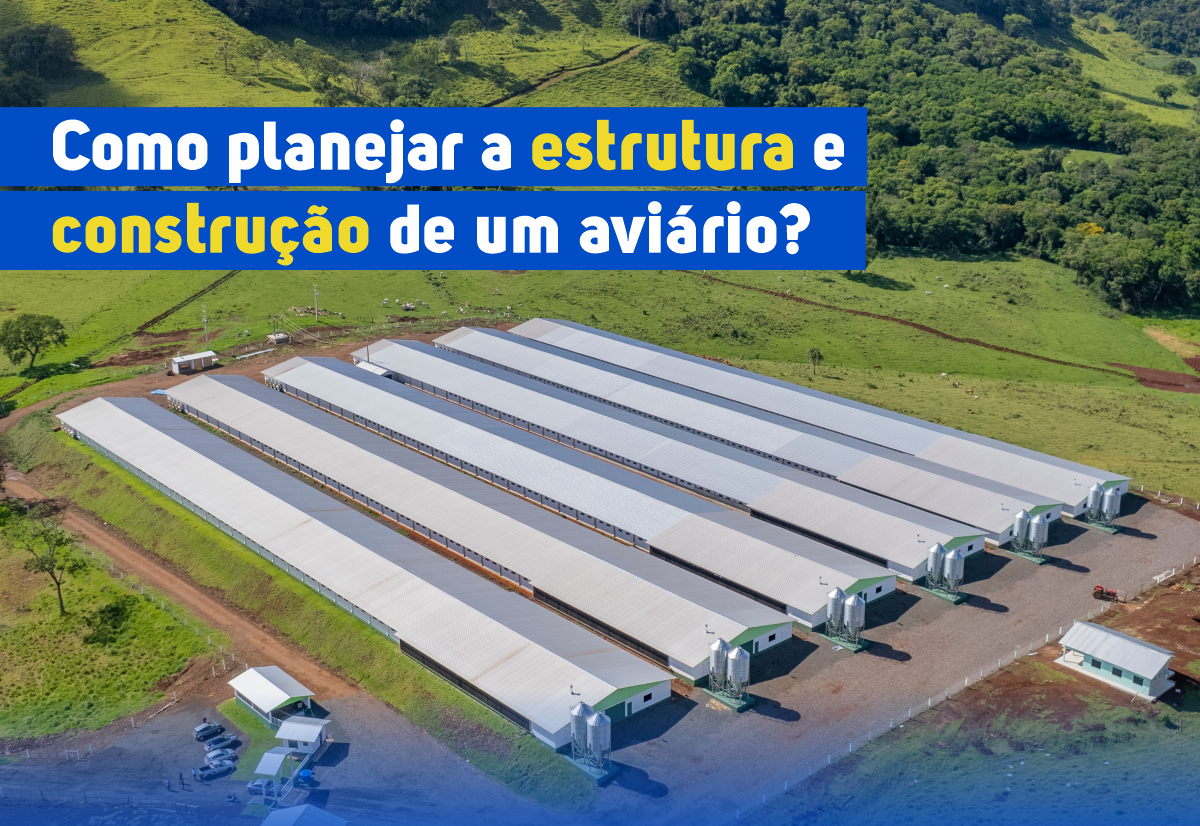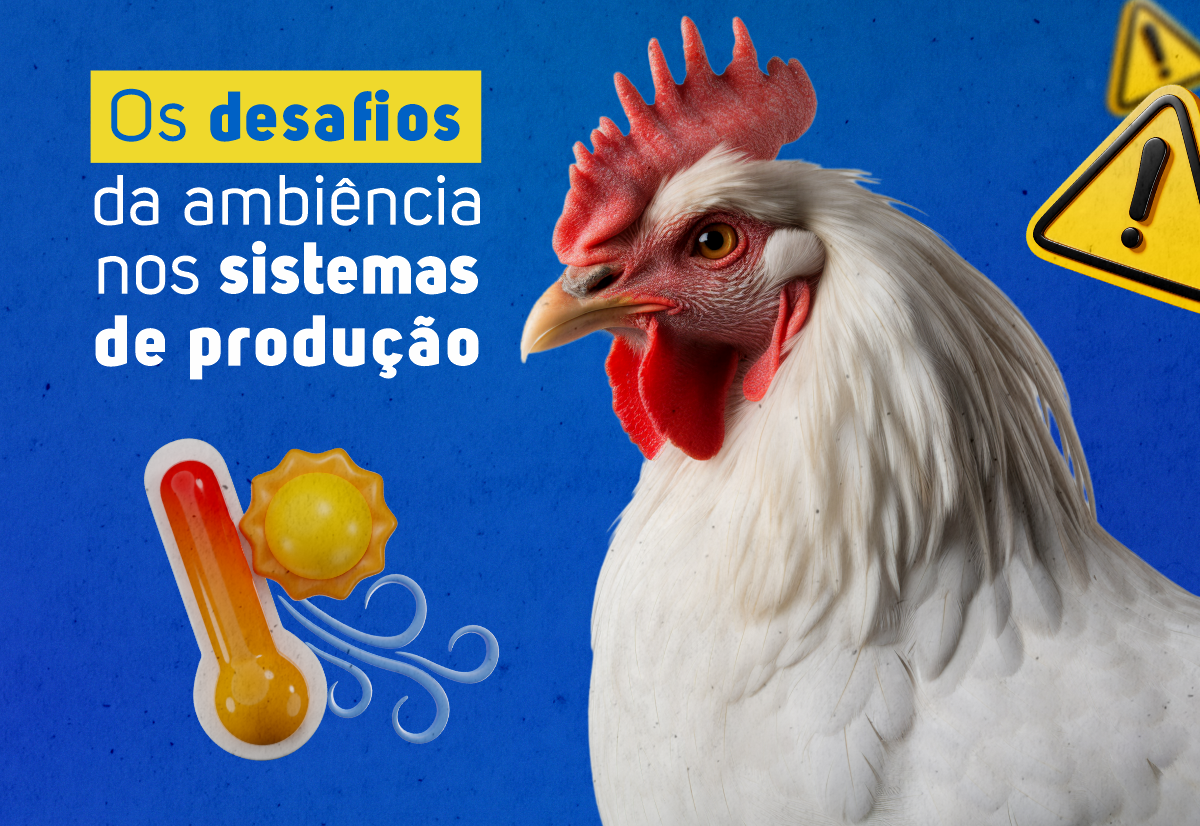
As it is a variable that influences all stages and categories of production, whether for broilers, layers or breeders, lighting in sheds must be carefully considered. Illuminance (lumens/m² = lux), distribution, color and duration of light affect flock performance, health and welfare. Proper positioning of light sources and their distribution encourage birds to seek food, water and heat during the rearing phase. During the growing phase, lighting can be useful to moderate weight gain and optimize production efficiency, being a useful tool also for harvesting and loading.
For many years, programs with photoperiods of 23 to 24 hours of daily light have been used by the poultry industry in order to provide maximum feed consumption. The use of this system allowed a better economic result. However, the genetic improvement provided the market with a different bird. Studies have emerged linking light programs with mortality, aggression and leg problems. Cutaneous lesions in the production of broilers are increasingly recurrent in poultry integration processes and are often due to productive and environmental factors, such as lighting, for example. Reducing the impacts of condemnation by skin lesions in the slaughterhouse is another point to consider when planning the lighting in the shed.
After several studies, researchers concluded that better performance and welfare of birds could be achieved with moderate photoperiods: increased hours of sleep, less stress, improved immune response, etc. (Lewis et al., 2004; Gous et al., 2004; Wang et al., 2005). But it should not be forgotten that lighting management must be thought out and planned together with the nutritional plan: one does not work without the other.
It can be seen that light management is a very useful technique with a low production cost and the principles surrounding the importance of lighting are: light source and wavelength (color of lighting), illuminance (quantity of lux), photoperiod duration and distribution (lighting programs).
VISION OF THE BIRD X HUMAN
Often in aviaries, the planning of lighting systems is based on human vision – which is a mistake. Considering that we now have a better understanding of how lighting, especially photoperiod, can affect breeding and producing birds, knowledge of birds' visual skills and their influence on key behaviors such as social recognition and feeding makes become a necessity.
But anyway: What is LIGHT? Light is electromagnetic radiation in the range of wavelengths that the human eye can perceive. This range of electromagnetic wave radiation detected by our eye is between 380 nm and 780 nm (1nm = 1 nanometer = 1 millionth of a millimeter)
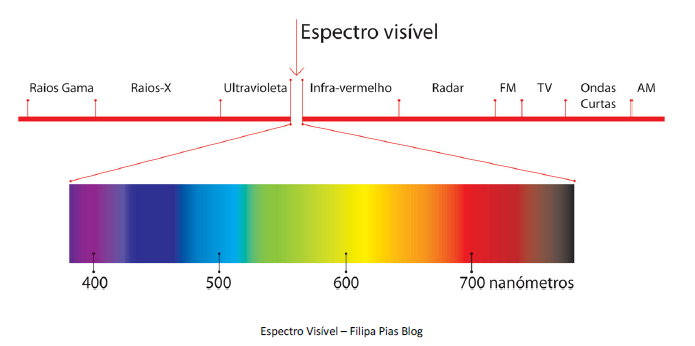
But notice in the Figure below that bird vision is distinct from human vision. The edge that the bird sees is wider, especially in blue and ultraviolet colors.
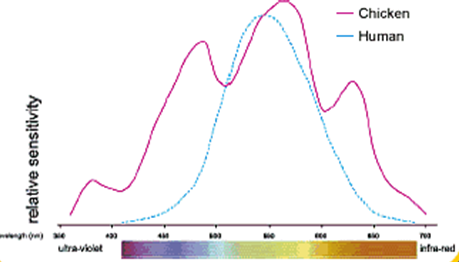
This is due to the fact that birds have relatively larger eyes compared to humans, that is, depending on the size of the head and the rest of the body, and it is up to us to understand that this is not the only difference between these two species in terms of the vision. There are two types of photoreceptor cells in the retina of the eye: rods, which are more numerous, highly sensitive and make it possible to see in low-light environments, and cones, which are responsible for normal vision conditions during the day. The image produced by the rods is poorly defined, as there are many images linked to a single nerve fiber. However, a sum of stimuli gives the rods a high sensitivity, at a maximum of 507nm (blue-green light).
Bird eyes have an additional type of cone in the retina with a peak sensitivity around 415 nm (Govardovskii & Zueva, 1977; Hart et al., 1999) and this cone allows the perception of radiation below 400 nm (Prescott & Waters, 1999). In addition, the lens of birds' eyes is optically around 320 to 400 nm, which means that birds can see a range of ultraviolet rays.
Several researchers address the effects of lighting color on birds, see Figure below.
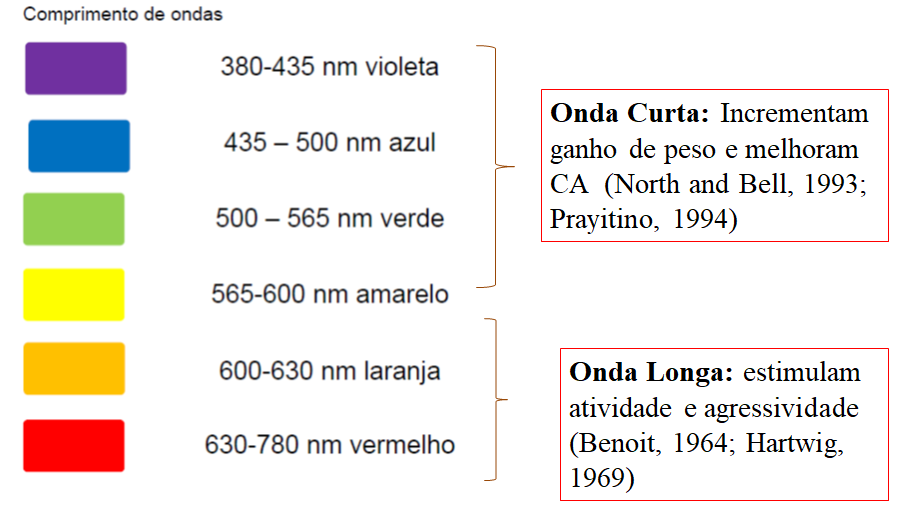
LIGHT SOURCES
The most common types of lighting in poultry sheds in Brazil at the moment are fluorescent and LED (Light Emitter Diode) lamps.
Fluorescent lamps have a higher initial cost, they actually produce more light per watt, but the intensity decreases over time and the lamps need to be replaced. This type of lamp also has a feature that deserves to be mentioned, this light source causes an oscillation imperceptible to the human eye, but visible to birds, also called flickering. Soon, the bird perceives numerous and very fast “blinks” in this type of lighting, which obviously causes visual discomfort to the birds.
LED (Light Emitting Diode) lamps are progressively replacing fluorescent lamps in urban areas and represent a technological advance in the ways of converting electrical energy into light. In poultry farming, the energy savings of this type of light source, the durability of its useful life, the low number of burned out light bulbs, etc., have been proven for a long time. There are numerous advantages.
Technically, LED lamps have other great advantages, such as using different wavelengths, that is, using the lighting color according to the age and category of the birds (green, blue, red, white light...). Very relevant is the ability of the LED lamp to be “dimmable”, which means that different illuminances (quantity of lux) can be provided with the same lamp. Therefore, the management of lighting nowadays is able to start the batch of broilers with 25 lux and finish the batch with 5 lux, for example: using the same lamp!!
The installation of lamps is a crucial point for the correct management of lighting. If the illuminance is the amount of light or luminous flux that reaches a unit area of a surface per second, when installing the lamps at a greater distance from the object to be illuminated, in the aviary for broilers it would be the bed, increasing the affected area and, therefore, the amount of lux is reduced. Therefore, computer programs that simulate the distribution of lighting in sheds are very useful.
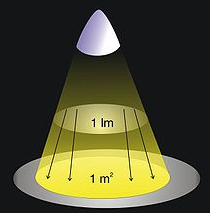
The distribution of lamps in misaligned rows, as in the Figure below, shows good homogeneity in the amount of lux on the floor of the aviary. They are large hexagons with a lamp in the middle and prevent one lamp from providing lighting on top of the other.
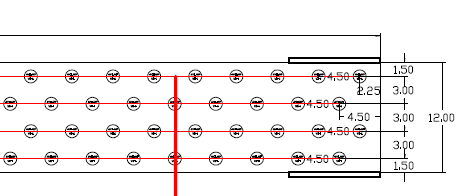
INFLUENCE OF LIGHTING ON BIRDS
Photoperiod is essentially a change in illuminance. Thus, color, which is essentially a change in intensity at certain wavelengths, is expected to affect the growth and behavior of birds. Visible light is a small collection of wavelengths, coming from a much larger series, and is called the electromagnetic spectrum. Old incandescent lights had a red light appearance, while white fluorescent lights had a bluish appearance. This is because incandescent lights produce longer wavelengths (red) while fluorescent lights produce shorter wavelengths (green and blue).
Researchers (Lewis & Morris, 2006) indicate that the ability of birds to visualize color is similar to that of humans, except that birds cannot accurately see shortwave light. This artifice has been used to facilitate the handling of chickens at the time of catching, that is, using blue lighting since they are calmer because they see very little.
Some specific wavelengths have a strong impact on certain production characteristics with similar effects in turkeys and broilers. Birds exposed to short wavelengths show better weight gain and feed efficiency. It is hypothesized that the effect on growth can be explained by the stimulation of the bird's activity by long-wavelength light, which penetrates the cranial cavity, and not by the effect of light on the production of gonadotropins. If activity is increased in birds exposed to long wavelengths and feed efficiency is worsened, weight gain may be compromised. During the early days of broiler rearing, shortwave light stimulates growth, while sexual maturity is accelerated by longwave light. There are studies investigating the possibility of using blue light during the entire growth of chickens. This stems from the fact that birds exposed to blue and green light remain calmer than those exposed to white or red light.
By: Angélica Signor Mendes (Full Professor at the Federal Technological University of Paraná, Campus Dois Vizinhos and the Postgraduate Program in Animal Science at UNIOESTE/UTFPR-DV)
Bibliographic references:
Gous, R.M. & Cherry, P. (2004) Effects of body weight at, and lighting regimen and growth curve to, 20 weeks on layng performance in broiler breeders. British Poultry Science 45, 445-452.
Govardovskii, V.I.; Zueva, L.V. 1977. Visual pigments of chicken and pigeon. Vision research 17, 537-543.
Hart, N.S.; Partridge, J.C.; Cuthill, I.C. 1999. Visual pigments, cone oil droplets, ocular media and predicted spectral sensitivity in the domestic turkey (Meleagris gallopavo). Vision Research 39 (20), 321-3328.
Lewis, P.D., Backhouse, D. & Gous, R.M. (2004) Photoperiod and oviposition time in broiler breeders. British Poultry Science 45, 561-564.
Lewis, P.D & Morris, T. (2006).Poultry Lighting – the theory and practice. Northcot: United Kingdon. 380p. 2006.
PRAYITNO, D.S.; PHILLIPS, C.J.C.; OMED, H. The effects of color of lighting on the behaviour and production of meat chickens. Poult. Sci. v.76, p.452–457, 1997a.
Prescott N.B.; Wathes, C.M. 1999. Spectral sensitivity of the domestic fowl. Bitish Poultry Science 40, 332-339.
Wang, C.M., Kao, J.Y., Lee, S.R. & Chen, L.R. (2005) Effects of artificial supplement light on reproductive season of geese kept in open houses. British Poultry Science 46, 728-732.
